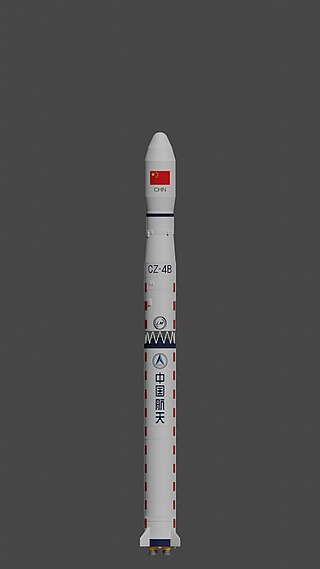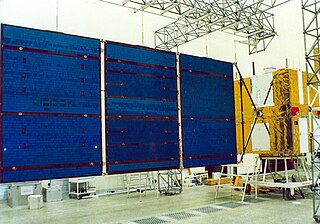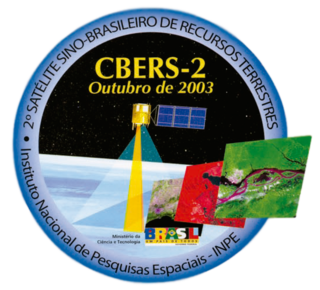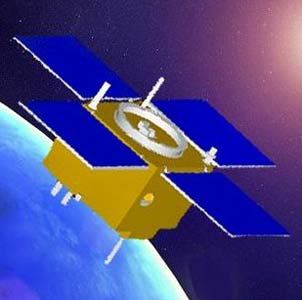Related Research Articles
The Long March rockets are a family of expendable launch system rockets operated by the China Aerospace Science and Technology Corporation. The rockets are named after the Chinese Red Army's 1934–35 Long March military retreat during the Chinese Civil War.

The Taiyuan Satellite Launch Center (TSLC) also known as Base 25 (Chinese: 二十五基地), is a People's Republic of China space and defense launch facility (spaceport). It is situated in Kelan County, Xinzhou, Shanxi Province and is the second of four launch sites having been founded in March 1966 and coming into full operation in 1968.

Fēngyún are China's meteorological satellites. Launched since 1988 into polar Sun-synchronous and geosynchronous orbit, each three-axis stabilized Fengyun satellite is built by the Shanghai Academy of Spaceflight Technology (SAST) and operated by the China Meteorological Administration (CMA). To date, China has launched twenty-one Fengyun satellites in four classes. Fengyun 1 and Fengyun 3 satellites are in polar, Sun-synchronous orbit and Low Earth orbit while Fengyun 2 and 4 are geosynchronous orbit.

The Wenchang Space Launch Site is a rocket launch site located in Wenchang on the island of Hainan, in China.

The Long March 4B, also known as the Chang Zheng 4B, CZ-4B, and LM-4B, is a Chinese expendable orbital launch vehicle. Launched from Launch Complex 1 at the Taiyuan Satellite Launch Center, it is a 3-stage launch vehicle, used mostly to place satellites into low Earth orbit and Sun-synchronous orbits. It was first launched on 10 May 1999, with the FY-1C weather satellite, which would later be the target in the 2007 Chinese anti-satellite missile test.

This comparison of orbital launch systems lists the attributes of all individual rocket configurations designed to reach orbit. A first list contains rockets that are operational or in development as of 2023; a second list includes all upcoming rockets and a third list includes all retired rockets. For the simple list of all conventional launcher families, see: Comparison of orbital launchers families. For the list of predominantly solid-fueled orbital launch systems, see: Comparison of solid-fueled orbital launch systems.

China–Brazil Earth Resources Satellite 1 (CBERS-1), also known as Ziyuan I-01 or Ziyuan 1A, is a remote sensing satellite which was operated as part of the China–Brazil Earth Resources Satellite program between the China National Space Administration and Brazil's National Institute for Space Research. The first CBERS satellite to fly, it was launched by China in 1999.

China–Brazil Earth Resources Satellite 2 (CBERS-2), also known as Ziyuan I-02 or Ziyuan 1B, was a remote sensing satellite operated as part of the China–Brazil Earth Resources Satellite program between the Chinese Center for Resources Satellite Data and Application and Brazilian National Institute for Space Research. The second CBERS satellite to fly, it was launched by China in 2003 to replace CBERS-1.

In 2015, the maiden spaceflights of the Chinese Long March 6 and Long March 11 launch vehicles took place.

Several new rockets and spaceports began operations in 2016.

This article documents notable spaceflight events during the year 2019.

This article documents notable spaceflight events during the year 2018. For the first time since 1990, more than 100 orbital launches were performed globally.
The Mohammed VI satellites are a series of two Moroccan Earth observation and reconnaissance satellites, namely Mohammed VI-A and Mohammed VI-B, developed and built by Airbus Defence and Space and Thales Alenia Space based upon the Astrosat-1000 satellite bus. They are Morocco's first optical imaging satellites, and are operated by Morocco's Ministry of Defense, with an expected service life of 5 years. They are named after Mohammed VI, the King of Morocco.
Tiankun-1 is a Chinese experimental technology demonstration satellite developed, operated, and launched by China Aerospace Science and Industry Corporation (CASIC). It was launched on March 2, 2017, and is designed in order to test its satellite bus, as well as small satellite operations. The satellite decayed from orbit on 7 July 2023.

The Long March 6A or Chang Zheng 6A as in pinyin, abbreviated LM 6A for export or CZ 6A within China, is a Chinese launch vehicle of the Long March family, which was developed by the China Aerospace Science and Technology Corporation (CASC) and the Shanghai Academy of Spaceflight Technology (SAST).

Shiyan is a Chinese experimental satellite program consisting of a variety of test satellites. Given the classified nature of the satellites, Chinese government statements regarding the missions of Shiyan satellites follow the common refrain of agricultural monitoring and space environment observation — the same offered for other classified programs such as the Tongxin Jishu Shiyan, Yaogan, and Shijian programs. Alternatively named Tansuo satellites, Shiyan satellites occupy varying orbits including low Earth, polar Sun-synchronous, geosynchronous, and highly-elliptical orbits and are believed to accomplish a diverse set of missions from rendezvous proximity operations (RPO) to earth imaging. Though similarly named, the Shiyan satellite program is not to be confused with the separate Shijian satellite program.
References
- ↑ Jones, Andrew (2024-03-27). "Long March 6A launches second Yunhai-3 satellite". SpaceNews. Retrieved 2024-03-29.
- ↑ "Technical details for satellite YUNHAI 3". N2YO.com - Real Time Satellite Tracking and Predictions. Retrieved 2024-03-29.
- ↑ "Yunhai-3 01". Gunter's Space Page. Retrieved 2024-03-29.
- ↑ published, Andrew Jones (2022-11-14). "Chinese rocket body breaks up in orbit after successful satellite launch". Space.com. Retrieved 2024-03-29.
- ↑ Jones, Andrew (2024-03-27). "Long March 6A launches second Yunhai-3 satellite". SpaceNews. Retrieved 2024-03-29.
- ↑ "Technical details for satellite YUNHAI 3-02". N2YO.com - Real Time Satellite Tracking and Predictions. Retrieved 2024-03-29.
- ↑ "CelesTrak: International Designator 2024-058". celestrak.org. Retrieved 2024-03-29.